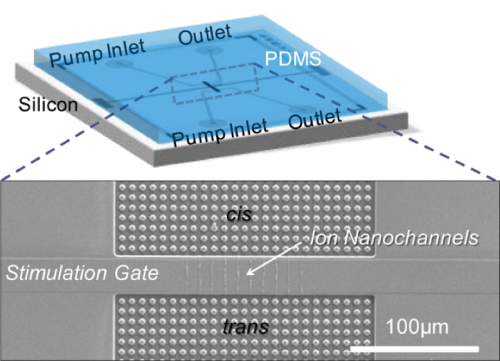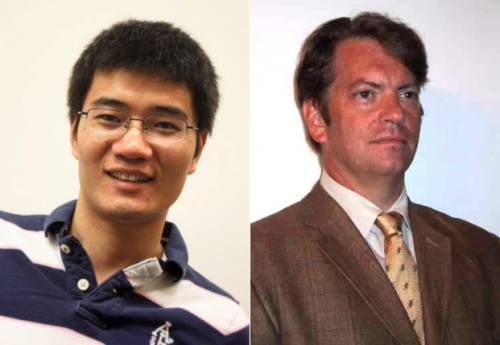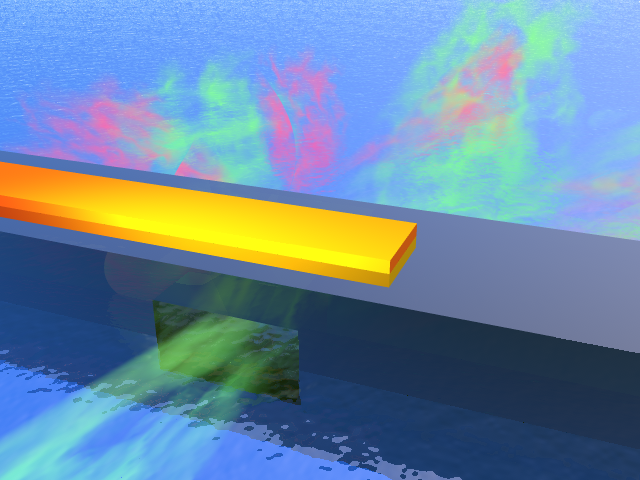Professor Mark A. Reed and Ph.D. candidate Weihua Guan of the Yale Electrical Engineering Department have produced a synthetic version of a crucial biological structure, the ion channel. Their research, published in the December 2012 issue of Nano Letters, represents the first successful attempt to do so. Their work takes an important step towards the creation of artificial cells, and also possesses several other practical applications.
In biological membranes, proteins form ion channels, which are pores that serve to facilitate and regulate ion flow. Ion channels make the membrane selectively permeable to only certain ions. They can also sometimes act as active transporters: when coupled with a power source such as adenosine triphosphate, they push ions against the gradient, from low to high concentration zones.
Guan and Reed’s device is able to perform both of these natural functions. An imitation of the voltage-gated ion channels normally found in neurons, the device possesses a capacitor that detects a third terminal voltage, an electrostatic potential that controls ion movement, and an adjustable electric field that makes the “nanochannels” selective for certain ions. Furthermore, the device is astonishingly small, with individual ion channels that are only 17 nanometers tall and one micrometer wide.
As an abiotic construct, Guan and Reed’s device is very easy to manipulate and possesses many potential applications. When provided with energy, their device can actively transport ions away from a solvent. This property can be used for tasks such as the desalination of seawater. The same process is also useful in reverse. When saltwater is added to one side of the device’s nanochannels and tap water to the other, diffusion of ions occurs. This diffusion actually generates voltage. Thus, the device can function as a battery that runs on seawater.

These applications, although readily achievable, are not yet practical. “At this moment, it’s not about technology; it’s about who needs it,” Guan says. The world currently has little need for microscopic seawater desalination or millivolt power production, but it is impossible to say what these applications could lead to in the future.
Due to their multifaceted set of functions ranging from enabling intercellular communication to generating the ion gradients that power cellular processes, ion channels are critically important to study. “If we can create something, we can understand it,” Guan states. He reasons that, in order to create an artificial ion channel, we must grasp fully and be able to apply the mechanisms and principles by which biological ion channels work. In this way, the present research helps solidify our understanding of biological ion channels.
Additionally, Guan’s and Reed’s artificial ion channel brings us one step closer to the creation of an artificial cell. This is presently an important goal because, as Guan explains, to construct the living cell is to understand life at its most basic level.

Currently, Guan is working to integrate the single device into a network of artificial ion channels. This project, when completed, will help model the organization of ion channels observed in actual biological systems. For example, in neurons, voltage-gated ion channels act successively to relay signals across the entire nervous system. Guan believes that this next step in experimentation will help us better understand the intricate interactions among individual ion channels within a larger network, possibly elucidating many basic principles in the operation of our own nervous system.
Through synthesis of nanotechnology, electrical engineering, and biology, Guan and Reed successfully built an artificial ion channel. While applications of their invention exist and are now being developed, the device’s greatest impact may be as a proof-of-concept technology. The device proves that we, today, possess a mature understanding of the single ion channel. By integrating the device into a network or even into an artificial cell, continuation of this research could reveal the mechanisms behind the function of ion channels in complex biological systems. In this way, Guan’s and Reed’s work possesses a unique ability to model and elucidate the complexities of life.


